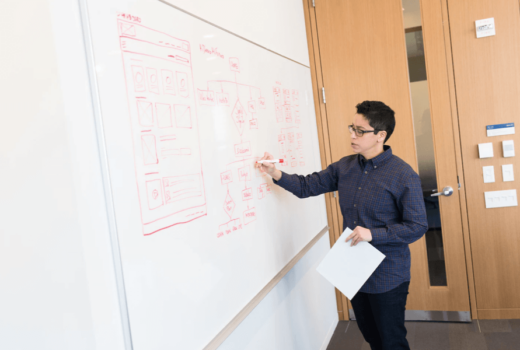Diversiteit daagt HO uit

“Diversity and Integration are critical issues of our time. Theyhave been of great interest to me all my life, and remainpriorities for me as Ambassador of the United States to theNetherlands. I imagine this is in part due to my own experience. Mybicultural Dutch-American background enriched my life and work andgave me a profound appreciation for the benefits diversity bringsto individuals and communities. And yet I experienced firsthandthat feeling of never fully “fitting in” as my “feet were always intwo continents.”
As an American, I embody a small part of my country’s history ofimmigration and integration. America’s progress in this area overthe years is a fascinating story. It wasn’t always an easy process,to say the least. Even today, just talking about our nationalexperience can sometimes elicit strong emotions in many of myfellow Americans. Because although we have made greatprogress – and I think we can be justifiably proud of that -we still have far to go.
Changing demographics
Our societies are undergoing profound social and economicchanges, and globalization accelerates these connections andinterdependence. Through immigration, the intermingling ofdifferent cultural and religious traditions, our populations becomemore diverse, every day.
Sharing our unique cultural identities offers us greateropportunities for self-expression and provides enriched pools ofideas and talent. The arts in America are a prime example. Theworks of Mexican-American painter Cecilia Alvarez, the music ofChinese American cellist Yo-Yo Ma, the magnificent poetry of theAfrican-American writer Langston Hughes – all these reflect theirauthors’ experiences as members of particular culturalgroups.
But they also transcend any group identity. Their contributionsare meant for and belong to all of us; they enhance America’scultural fabric, and unite us through its diversetexture. Many worry that changing demographics can alsofragment our communities, threaten social stability, and underminea shared sense of national identity. And nowhere is the challengeof accepting and embracing new cultural identities and beliefs moreprofound than in our schools, universities and colleges.
For these key institutions are responsible for the development ofour young people and the maintenance of our democratic systems. Soit is necessary to look closely at the role of diversity ineducation. I commend and thank INHolland University for bringing ustogether for that purpose.
Diversity in education is never merelytechnical
For me, there are two basic questions we must address.How does diversity play a role in education? Should the coreinstitutions of democracy, including schools of higher learning,teach diversity as a value and work toward it as a goal?
We know that education can never be merely technical, and thatschools must also prepare young people to succeed as individuals,as productive workers, and as responsible members of society.Interaction among students within a diverse student body provideslearning experiences that prepare them to function in ourincreasingly heterogeneous societies. By interacting with otherswith different backgrounds and life experiences, students confrontperspectives and views different from their own. This providesopportunities for students to question the status quo, toarticulate their thoughts, and to expand their beliefs.
Research shows that interacting with students from differentbackgrounds helps young people develop higher levels of criticalthinking, active thinking, and interpersonal skills. They alsodemonstrate greater engagement and motivation. Students on diversecampuses generally experience enhanced classroom discussions anddevelop a greater ability to understand differingperspectives.
These skills help them navigate the complexity and diversity ofsociety — to recognize, value and learn from different communitiesand cultures. This is not merely desirable but fundamental, giventhe world in which they will live and work. Campus diversityteaches students to negotiate and function more effectively withincomplex professional environments. It also provides opportunitiesto view problems from multiple perspectives.
Diversity in the workforce
This is something we take very much to heart in theUnited States. The true exchange of ideas requires sensitivity toothers’ views, values, and beliefs. Given the changing demographicsin America, the increasing diversity in our workforce, and thegrowing global marketplace, the ability to understand and integrateculturally different perspectives is a critical skill.
Global corporations like Microsoft, General Motors, and Proctorand Gamble value students who have been exposed to diverseinfluences. For example, General Motors has an aggressive programto ensure diversity in its work force. Its mission statement citesthe company’s goal to “reflect the world in its multiculturalworkforce, which is a critical link between the workplace and themarketplace.”
These companies recognize employees’ diverse perspectives assomething that helps them understand the global marketplace,develop better products, and deliver better services. GM’s supportof student affirmative action, for example, helps ensure thatcollege graduates entering the workplace are as diverse as they areeducated. Having a diverse population helps students defineproblems in unique ways and entertain a broader array ofsolutions.
My cross-cultural hometown Chicago
Finally, democratic societies require contributingcitizens in a society to believe in inclusiveness, and respect forothers. Future citizens and leaders will be more effective indiverse societies if they are educated in an environment thatprofesses these values and exercises them as a natural part ofeveryday life. In short, a diverse student body and itscross-cultural interactions ensures that students are comfortableworking with colleagues with different views, and are attuned toincorporating diverse perspectives.
But all of this cannot happen simply because diverse students arethrown together to work and play. Schools must create theconditions to enable diversity to thrive, within and beyond theclassroom. I am sure you will be impressed to hear about the
Mom’s campus visit
I would like to close with a personal story that illustrates manyof the thoughts I just discussed. When my children went to college- and in America as you know, many young people leave home and liveon campus – I kept in touch with them mainly through telephone ande-mail. During their first year, they told me about theirexperiences in school, the people they were meeting and thefriendships they were developing. Many months after they had lefthome, I visited them on campus and met their friends. I found thattheir friends were African, Asian, Latino and other.
My children had never mentioned their friends’ culturalbackgrounds, just their hometowns in our conversations. It struckme that they had moved beyond all of that, beyond defining oneanother by ethnicity or race. They were, as we say, “color blind.”And I have to admit I was proud.
But this is the result of the collective work of previousgenerations before them, of political will embodied in federalprograms, in state and local initiatives, and of the efforts ofcommunities and individual people throughout our history to get uswhere we are today.
And today is certainly better than yesterday, but tomorrow must bebetter still. We have great responsibilities before us, to protectwhat has been achieved and to continue our commitment to building amore inclusive community for us all.”
De volledige speech van de ambassadeur Hartog Levin vindt u
Meer over Mix-In vindt u
Meest Gelezen
Vrouwen houden universiteit draaiende, maar krijgen daarvoor geen waardering
Wederom intimidatie van journalisten door universiteit, nu in Delft
Hbo-docent wil wel rolmodel zijn, maar niet eigen moreel kompas opdringen
‘Burgerschapsonderwijs moet ook verplicht worden in hbo en wo’
Raad van State: laat taaltoets nog niet gelden voor hbo-opleidingen



